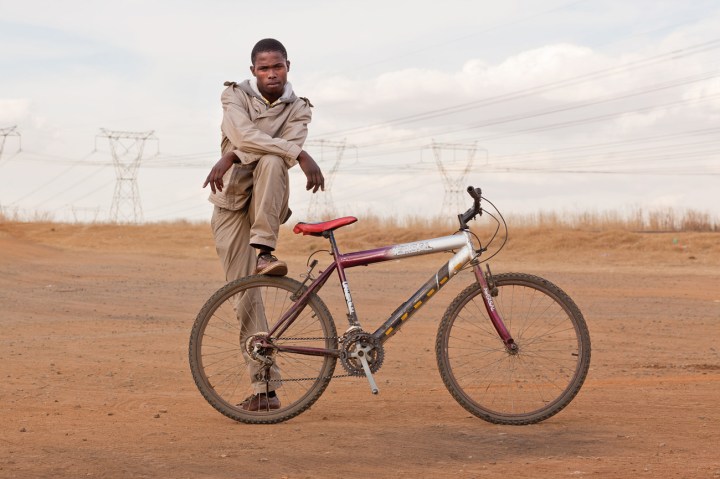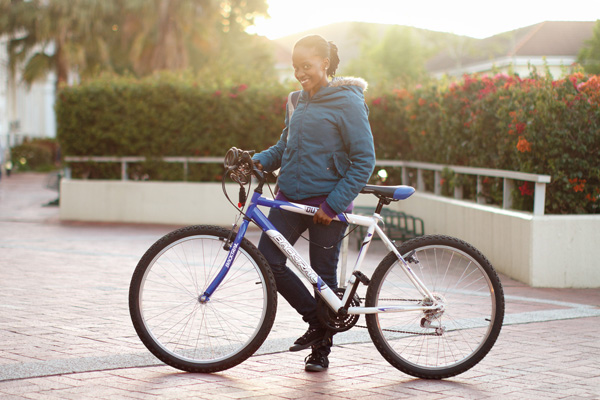Africa, Maverick Life, Media, South Africa
I want to ride my bicycle: Africa’s waiting

A new photographic project by two Capetonians explores the world of commuter cycling in South Africa, giving us intimate portraits of bike riders and their trusty steeds. REBECCA DAVIS doesn’t ride a bicycle, but she might start after this.
The bicycle occupies a curious position in South African culture. On the one hand, it’s long been associated with the poor – those who couldn’t afford motor vehicles. On the other hand, it’s an increasingly fashionable mode of conveyance for a new generation of hip urban youngsters. For the first time in South Africa’s history, riding a bicycle might soon no longer carry connotations about class and money.
This certainly hasn’t been the case up to now. In a fascinating essay about bicycles in South Africa by JM Coetzee, he notes that “even in the golden age of the bicycle in the early 20th century, the bicycle did not catch on widely in South Africa”. He suggests distance as a deterrent factor, and sparse road networks didn’t help. Bicycles simply never became big as transport for commuting in this country.
“Recreational cycling took off in the 80s among middle-class whites, who took their lead from the explosion of recreational cycling in the United States,” writes Coetzee. “It is one of the ironies of history that the first generation of white recreational cyclists, donning their multicoloured Lycra outfits and venturing on to the public roads on their fancy imported bikes, had to cope with attitudes on the part of motorists ranging from impatience to hostility, attitudes inherited from a past when the roads belonged to whites in their cars and anyone riding a bicycle was a cheeky trespasser.”
The essay is printed in one of three books just published by Stan Engelbrecht and Nic Grobler, entitled Bicycle Portraits. It’s a simple title for a simple concept – the books contain precisely that. In total, the three books feature 162 photographs of South African cyclists and their bikes. But these are not Argus Cycle Tour riders or the recreational middle-class cyclists of Coetzee’s description. The creators only photographed ordinary South Africans who use their bicycles as an everyday mode of transport.

Photo: Tshepi Moloko, by Stan Engelbrecht and Nic Grobler.
Engelbrecht is a photographer with several previous books to his name, including Caution Horses, the result of several months spent winning the trust of the wild horses of the Namib Desert. Grobler is a graphic designer by training. They share a passion for bicycles, and that is how the project came to be.
“The idea came out of a conversation over a few glasses of red wine,” Engelbrecht says. “We decided that the next day we would go out and look for an everyday South African who rides a bike, and take his picture. In two hours, we didn’t find one single person.”
Engelbrecht explains that they originally had conceived of the romantic idea that they would come across a person on a beautiful hand-me-down Italian racing cycle. “Instead we eventually found a dude on an old mountain bike.” That day, the duo photographed three or four people. Then 50. Then 100. Eventually there were over 500 portraits, and a story to accompany each one, giving a snapshot into the lives of the people in question. In order to take these photos, the two men embarked on a two-year cycling journey around South Africa, including building a pair of bikes in Maputo and riding them back to Johannesburg.
“Our routes were organic, they just kind of happened,” says Engelbrecht. “Sometimes we’d set out by train, and then just cycle in a certain direction. We wanted it to be an adventure, with no time schedule or quotas.”
The bike owners were, on the whole, happy to be photographed. Engelbrecht can only recall two or three people declining over the course of the entire project. He attributes this to the camaraderie that exists among bike riders. “Because we arrived on our bikes, there was a kind of understanding or sense of community, that this other person is somehow a little bit like you.”

Photo: George Tsogoro, by Stan Engelbrecht and Nic Grobler.
The portrait subjects are wonderfully diverse, unified only by the bicycles they all ride, though the bikes, too, are very different. One of the most distinctive portraits is that of John Jacobs from George, a scrawny man with a tattooed frame, photographed T-shirt-less, clutching the handlebar of his bike, with his head thrown back in laughter, eyes closed. The accompanying text, written in the first person, explains that Jacobs spent time in 14 jails between 1974 and 1987.
As for the bicycle: “My cycling, I’ve been riding for 12 years and I enjoy it. This is my tenth bicycle. Every winter I have to pawn my bicycle at the pawn shop because I don’t have work. Then when I get money again I have to go fetch my bike, and sometimes it’s gone. Then I have to get another one.”
Then there’s Stephanie Baker, “82 and three-quarters”, photographed in a floral dress with her bicycle on a leafy Pretoria avenue. Baker’s account: “I’m limited to about a kilometre in view of my age, and I use it. Well, certainly every other day… about a kilometre uphill in Pretorius Street. I keep on the pavements, they’re in a terrible state with chunks missing, but cycling is awfully good for public relations.
“I know the area’s cleaners at the flats on my way to church: I get a greeting from them. The security men at the forensics place always wave, and going along you sort of get to know people. Often you see someone really looking quite gloomy and you sort of give a smile and say dumelang and get a smile back.”
Some of the bicycles aren’t in the best of conditions. Many have been ingeniously repaired with household objects. Edward September was photographed in dusty De Aar, Northern Cape, carrying only the frame of a bike, sans wheels. “I’m off to go and sell this bicycle as I don’t have the rest of the parts working anymore or money to fix it,” September explained. “I’m going to the scrap yard. They weigh it there. Maybe they’ll give me R12 or R11. I already took the wheels. When the bicycle was working I used it every day: people sent me to fetch things.”
Whatever the condition of the bicycles, Engelbrecht says their owners were invariably proud of them. “People love their bikes. And during the course of the project I started loving all bikes too, everything from the shittiest R400 supermarket bike up.”
Despite the diversity of the riders, Engelbrecht thinks there is a profile of a typical bicycle commuter in South Africa.
“Often it’s someone who’s a little bit eccentric in their community, because of the social and cultural stigma still widely attached to bike riding,” he says. “They aren’t generally part of a cool subculture. More often than not they were inspired by a family member to try commuting by bicycle, and it just becomes a way of life.” But he’s at pains to stress that the total community of bike riders defies any stereotypes.
By way of illustrating this, he tells a story about Johan Schade, the first cyclist they ever photographed, the “dude on an old mountain bike”. Schade was photographed riding his bicycle home to Milnerton from his workplace in Bellville. Schade explained at the time: “This bike is a bit customised. It’s been coming along for 13 or 14 years already. It’s been through off-road riding, it’s been ramped – my friend even towed me with a motorbike. I held his hand and he pulled me down the N1 highway.

Photo: Johan Schade, by Stan Engelbrecht and Nic Grobler.
“The fastest he said we were going was 140km/h. Then my front bearing seized up and the wheel locked. I went over the bars. When I was younger I rode BMX and stuff. I’ve broken everything: legs, arms, even hurt my back. Been to the ICU. Been all over.”
After the project’s completion, Engelbrecht contacted Schade to give him his copy of the book (each person photographed received a copy). He also asked Schade if he would like to attend ”Critical Mass”, a group cycling event normally held on the last Friday of every month in central Cape Town.
“He rocked up on his old bike, he’s barefoot, he’s a diesel mechanic, and I was worried he might feel out among all these hipsters with their checked shirts,” Engelbrecht explains. “But it totally wasn’t like that. Everyone was chatting to him, nobody snickered at him, they were just talking and riding.” For Engelbrecht, this epitomises the friendly spirit of the cycling community.
There’s one thing I’m curious about. How the hell did Engelbrecht and Grobler get the notoriously reclusive Coetzee to write them an essay about bicycles for their book?
“I just emailed him,” Engelbrecht replies simply. “I knew he was a cycling enthusiast.” (The staid Nobel prize-winner in Lycra? The mind boggles.) “His novel Slow Man features a man who loses his leg in a cycling accident. People warned me that Coetzee could seem private or cold, but I just refused to believe that he wouldn’t even write back. So I emailed him a second time, and on that occasion he replied within five minutes, explaining that he had been travelling for work but he’d looked at the project, really liked it, and would be keen.”
The books are almost worth purchasing simply for Coetzee’s elegant, personal essay, but it’s obviously the photographs that are the main attraction. Capetonians can currently view some of the portraits by strolling through the Company Gardens, where they are on display.
All the portraits are also freely available to view online, in keeping with Engelbrecht and Grobler’s desire to keep the project “entirely public and visible”. On the website you can also buy copies of the books for delivery. By bicycle, of course. DM
Read more:
- Bicycle Portraits website.
Photo: Freddy Mashaba, by Stan Engelbrecht and Nic Grobler.
















 Become an Insider
Become an Insider